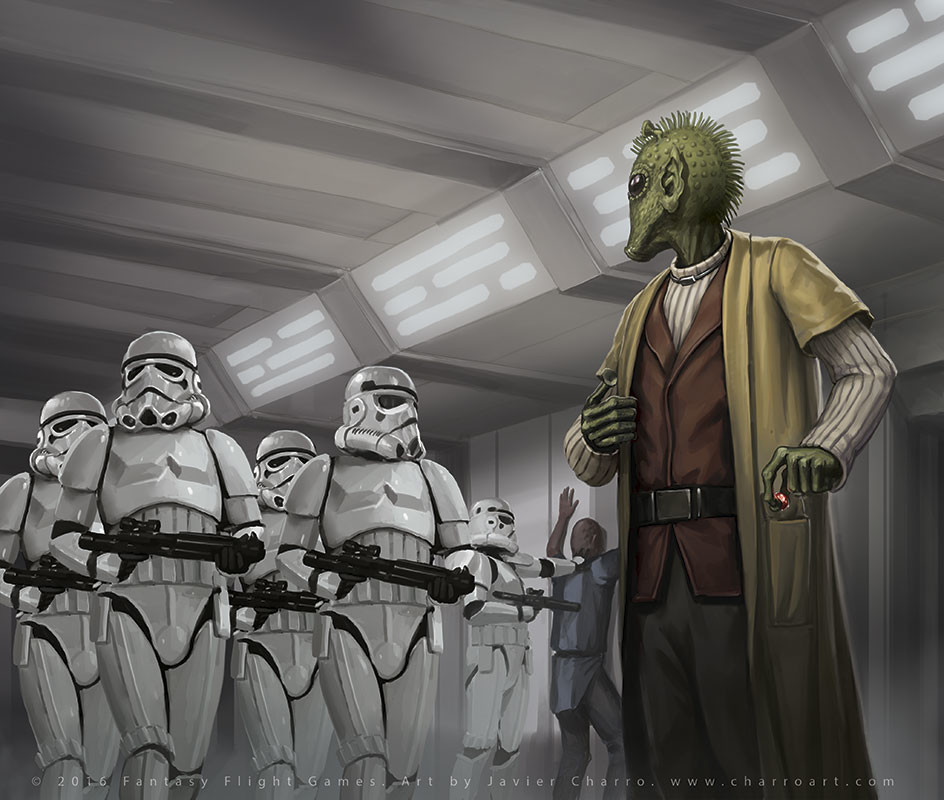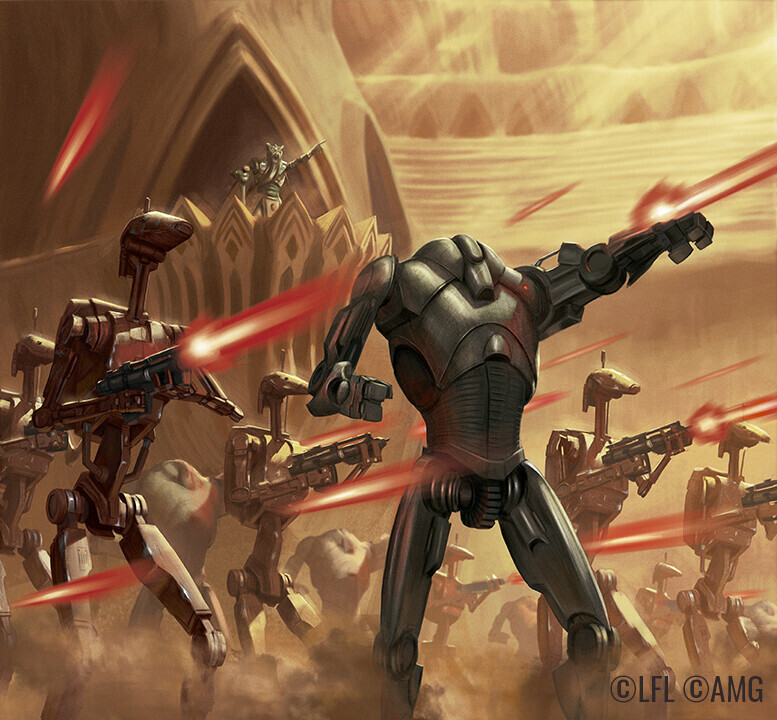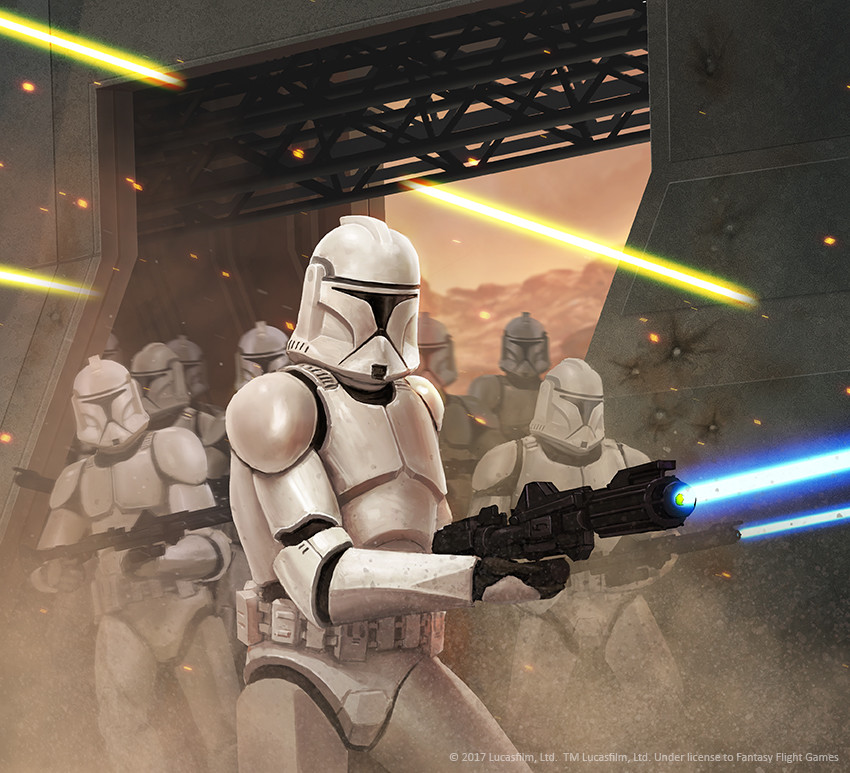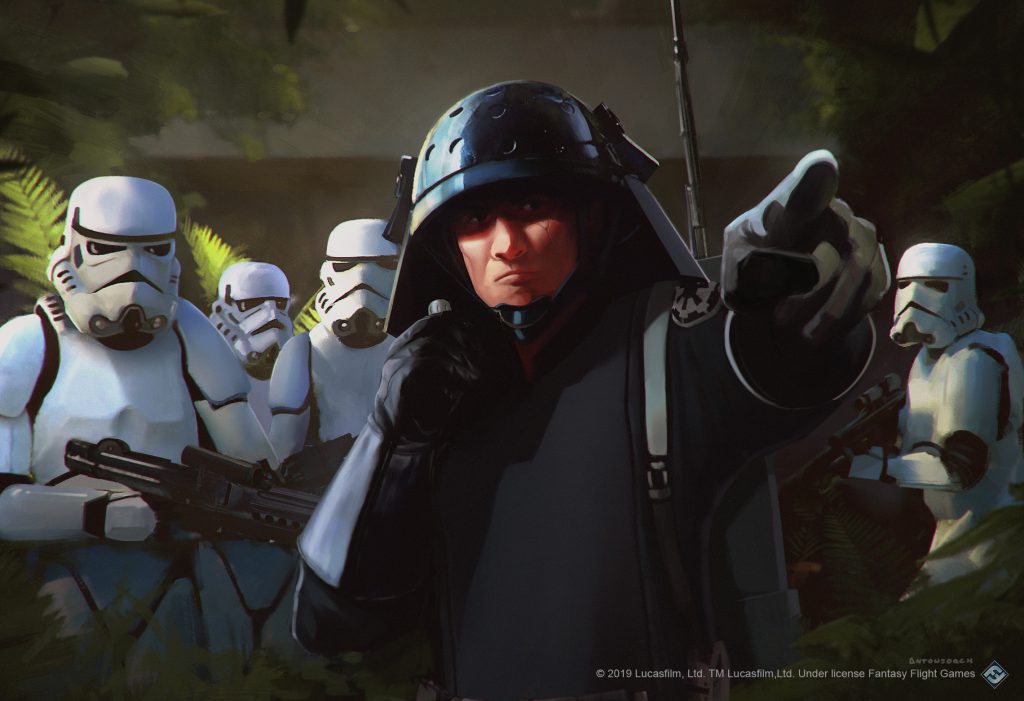One of the game-defining changes packaged with the revamped Legion rules is the option to take double-sized corps units via a personnel upgrade. This will be the way going forward as many future corps kits will have twice as many models as we’re used to.
What does this mean for gameplay? Join me while I try to work that out for myself.
Wide Load Incoming – “200,000 units are ready with a million more well on the way.”
The simple version is that the new player cards that arrived last month came with a new ‘Squad’ personnel upgrade for various corps units. These upgrades share the same basic characteristics:
- They are referred to as [unit name] Squad
- The upgrade roughly doubles the number of basic models in the unit, with nuances.
- The formula for a unit with 1 personnel slot taking a Squad upgrade is: (base unit x 2) + 1.
- A base B2 Super Battle Droid unit is 3 models. The B2 Super Battle Droid Squad adds 4 models to the unit and brings it to 7 models without affecting other slots.
- Heavy weapons and other personnel-type slots (like the squad leader slot for the Republic) are unaffected.
- The whole unit gains Indomitable.
- “When a unit that has the Indomitable keyword performs its Rally step, it rolls red defense dice instead of white defense dice.” (p. 51, Core Rulebook)
- Statistically, this doubles your chances of removing a suppression token with each die rolled.
- The Cohesion range for the unit is increased from Half-Range to Range 1 of the unit leader.
- The unit cannot be Transported or issued orders using the Transport keyword.

In short, your unit roughly doubles in size, is twice as resistant to suppression, can’t be transported, and gets a cohesion range boost to make up for the extra size. Everything else follows from that.
Pros and Cons – “Twice the pride, double the fall.”
Going double-wide with your corps doesn’t necessarily double its efficiency. Sure, it massively increases the unit’s staying power and dice pool, but you’re taking major hits in other areas. There are a variety of hard (quantitative) and soft (qualitative) characteristics that these units bring to the table.
Hard Characteristics
- Reduced activation count compared to smaller units.
- Greatly increased unit cost.
- A Rebel Trooper unit with the Squad upgrade is 85 points.
- Note that this may still be more cost-effective per model. A base Rebel Trooper unit is 10 points-per-model (ppm). The Squad upgrade’s models are priced at 9 ppm.
- A Rebel Trooper unit with the Squad upgrade is 85 points.
- Increased dice pool (varies per unit).
- A Clone Trooper Infantry squad goes from 1.67 average hits vs. white dice to 3.75 after the Squad upgrade.
- These increased dice pools can be devastating. A slightly high roll from these new units can wipe out a smaller, unprepared squad.
- Increased unit durability (varies per unit).
- Doubled suppression token removal during Rally steps.
- Reduced mobility due to loss of transport access.
- Massively increased cohesion range: Half-Range to Range 1.
- Assuming that the leader model is a point in space, a Half-Range cohesion circle has a surface area of 28.27 in². Doubling the cohesion radius to Range 1 (6 in.) increases the surface area of unit cohesion to 113.1 in².
- Doubling cohesion from Half-Range to Range 1 quadruples the surface area available for cohesion.
- The actual figures for cohesion area are larger since the unit leader occupies its own surface area and is not a point in space.
- Point-cost efficiency changes:
- Better board coverage per corps slot.
- Better unit-wide upgrade efficiency (gear, training, etc.).
- Worse at reaching army minimum corps slot requirements.
- Worse heavy weapon saturation.
Soft Characteristics
- Much higher order efficiency.
- Increased holding power over single objectives.
- Conversely worsened ability to secure multiple objectives.
- Greater difficulty in using cover and LOS-blocking terrain.
- Better at blockading board surfaces, especially chokepoints.
- A strong contender for all of your eggs in one basket.
- Anything that can harm the whole unit is comparatively more devastating.
- Every weapon with the Spray keyword is cackling gleefully.
- Anything that can harm the whole unit is comparatively more devastating.
- More investment to paint and transport.
- Let’s not ignore the fact that the new double-sized corps boxes will have an inevitable price hike and people who don’t enjoy painting them will need to paint even more.

Let me be direct: doubled squads are powerful. Each unit represents a concentration of force that is impossible to ignore. Orders issued to these units benefit about twice as many models. Their dice pools can demolish weaker units. They’re hard to suppress and harder to shift wherever they plant their feet.
Despite these strengths, they’re not the end-all of corps firepower. Thankfully, they have a few key weaknesses commensurate with their strengths. Extra firepower is neat, but oversized units can only contest one objective at a time in a ruleset that strongly favors take-and-hold gameplay. Likewise, losing a corps unit of this size can damage your ability to control whole sections of the board. Competitive play relies on squeezing every bit of efficiency from each unit. Small shifts in cost-effectiveness or utility in a list with many moving parts can overturn their value entirely.
To simplify things for the folks on the ground, let me discuss when you’d want to consider these units vs. sticking to a regular corps unit.
Use and Disuse Cases – “Droids seldom take prisoners, sir.”
Firepower Saturation
Corps firepower is complex, but intuitive. It speaks to good game design, but is still worth breaking down.
Corps units often back-load their ranged firepower into heavy weapons. Typical corps units bring one die of ranged firepower per generic model (B2 Super Battle Droids excepted). Heavy weapons bring a lot more firepower than their generic counterparts.
Adding a Z-6 means throwing 6 dice. 6 is better than 1, even if the individual dice are worse quality. The infamous RT-97C rolls 4 more dice at an extra range bracket over the base weapon. The cost of heavy weapons isn’t directly proportional to their damage output, either. That RT-97C stormtrooper is 2.63 times more expensive than a generic stormtrooper in the personnel slot. It generates nearly 6 times as many hits as one trooper at a longer range. The general trend holds true whether you reach for a Z-6 or E-5C B1‘s.
Takeaway: If you want to maximize corps-level firepower, it is crucial to take more corps units with relevant heavy weapons. This increases firepower per point while also saturating the board with heavy weapons from different angles.
Corps units can be tuned to do awesome things. They’re cost-effective objective holders and board control units. For armies that need it, they also provide a base-of-fire. They give your force the firepower and suppression needed to cover the advance of more specialized units.
This is where Squad personnel upgrades fall short. They only boost the worst-value base weapons in a unit. The 5 extra B1 Battle Droids in the B1 Squad upgrade contribute 1.04 hits to the squad (vs. white saves). A lone droid clutching an E-5C contributes 1.25 hits – more than the entire Squad upgrade. It’s also 20 points cheaper.
Takeaway: When taking Squad personnel upgrades, get use out of their basic weapons. You’re paying for durability and firepower, so sitting around without shooting is a vicious waste of the points spent on their weapons.
But that’s still not the full story.
If you want to maximize the firepower of a single corps unit, the rules change. Slapping the Squad personnel and heavy weapon upgrades onto your unit gives you the biggest dice pool possible. It’s a buckets-of-dice approach the Orks would be proud of.
A Shoretrooper unit with the Squad upgrade and T-21B trooper averages 6.35 hits against white saves. No shenanigans or tokens. Just roll and surge. A couple flubbed saves and you just sneezed an infantry unit off the table.
The decision to go maximum firepower on your corps units falls on your willingness to sacrifice board control for damage. A comically oversized unit with heavy weapon troopers and other upgrades is the strongest firepower bloc you can squeeze into a corps slot. It’s also terrible at securing multiple objectives. It’s also a stellar candidate for deletion at the hands of a flamethrower-wielding Boba Fett.
Sacrificing board control is rough for units who were made for the role. But here’s a compelling counterargument: hosing an unlucky enemy squad off the table is a form of board control.
Takeaway: If you want to maximize the firepower of a single corps unit, you should take Squad upgrades, heavy weapons and everything else you can get. Your B1 battle droid squad is now over 100 points. Try not to lose it.

Board Control
I keep using that term, so I guess I should elaborate.
Board control describes your ability to influence the battle area and limit your opponent’s ability to do the same. It’s the ability to fan out and cover objectives. It’s having infantry in a key piece of heavy cover with wide fields of fire. It’s the freakish distance Darth Vader can cover with Implacable before Force Pushing a squad off its objective into the open.
Board control is relevant in any conflict over a limited space. In chess, it’s about securing the center and manipulating that space to your advantage. In counter-insurgency operations, it tells you exactly why nobody wins at counter-insurgency.
In Legion, it’s a sleeper win condition. If you sit in so-called ‘friendly-territory’ all game, you’re staring down defeat while the opponent crawls onto objectives and racks up points. Even if you realize that this is a bad idea and sally forth in Round 3, you’ll have far less space to maneuver because someone parked a fucking Dewback on the barricade you covet.
If you’re not running some kind of skew list with minimal corps and lots of special forces or creature troopers, the corps rank is most of your board control. They’re tailor made for it:
- They’re mandatory. You’re stuck with them, so you might as well use them.
- They’re always reasonably mobile and never immobile.
- You always get at least as many corps slots as any other unit type.
- Wanna really mess with the board? Try the new 6 troopers + 6 emplacement troopers option that was recently made possible.
- They’re rarely specialized enough to warrant another job.
- Lots of bodies at bargain bin prices.
Double-wide corps upgrades dramatically change the arithmetic of board control.
For one, they’re a lot worse at influencing multiple objectives. Contesting an objective is based on having un-panicked unit leaders nearby. More points spent on oversized corps units means less points for unit leaders. This is even more painful now that objectives are scored continuously.
However, there is soft power inherent to piling bodies onto the table. Contesting an objective is easy – just plant your unit leader’s ass on it. Keeping it is hard. An oversized squad has extra staying power from its enormous wound pool and panic resistance. They’re much harder to kick off an objective that they already hold.
Takeaway: Oversized corps units weaken your ability to contest single objectives, but are prodigiously difficult to remove from an objective they do hold. Use them to secure objectives that are less contested or vulnerable to chip damage damage until they can advance.
Besides objective control, having more models is a great way to influence positioning on the table. A blob of corps units impedes enemy movement by their very existence. More bases make it proportionately harder to get units overhead to the other side. This value is increased in chokepoints where your models can queue up and obstruct crucial areas.
The unit’s durability also doubles the effort needed to clear the area they’re occupying. Units that were previously dispersed by chip damage now require concentrated firepower. If a double-wide unit of B1s makes an opponent reconsider their decision to move between two buildings, it’s done a great job already.
Takeaway: Use oversized corps units to block chokepoints and obstruct movement, freeing up more valuable units for maneuver warfare. The extra bodies are advantageous whenever they’re not clogging up your line.

Size Efficiency
Leaving the realm of individual stats and tying things to the big picture, we have this topic. The efficiency of large corps units for unit-wide abilities and orders has been a persistent topic of discussion. For the troops that benefit, it’s an easy win. Each order issued to an oversized corps unit affects a larger portion of your army and therefore, becomes more efficient. Some orders and upgrades give unit-wide buffs that go much further on large units. Classics like Ruthless and New Ways to Motivate Them are great picks because a large unit can easily absorb a wound and the bonus action is so much more impactful.
The flipside is that anything granting a limited, quantitative benefit doesn’t get the same improved efficiency. One aim token from Offensive Push is still one token. Likewise, area-of-effect abilities like Return of the Jedi favor large numbers of smaller units.
I won’t discuss the other problem of activation counts here since it’s been covered so extensively. Taking larger units exposes you to a lower activation count. Although pass tokens have come a long way to mitigate that, activation advantage is still important and your initiative will dwindle rapidly as large corps are lost.
Takeaway: Use oversized corps units carefully, rather than adding them without consideration. They benefit greatly from command cards, gear, and abilities that provide unit-wide buffs, but your activation count will suffer.
Size matters, of course. The size efficiency of Squad personnel upgrades cuts both ways and there’s some pretty good counterplay against them. This is evident with the resurgent interest in Flametroopers and Boba Fett (Empire). Anything with the Spray keyword is hot property since Spray attacks scale up against unit size. The Imperial Boba Fett leads this charge with two flamethrower options, Arsenal 2, and the mobility to bring it all to the hapless enemy.
Flamethrowers aren’t the only form of conflict resolution here. You Serve Your Master Well becomes a battlefield terror that turns an oversized dice pool against your opponent. Works on your own giant corps units too. The target doesn’t even have to be biological, so you can mind trick droids into a friendly fire incident. So push this command card up the priority list if your environment is being saturated with big Shoretrooper squads.
Every faction has its own mass-target option that was stealth-buffed by large corps units. Asajj Ventress appreciators have I Am Fear. Din Djarin’s flamethrower and Whistling Birds are a strong alternative to Boba Fett’s incendiary antics. Even R2-D2 can burn things!
Turning size efficiency against the opponent takes a bit of forethought. Most of these possibilities are known to Magic: The Gathering players as tech upgrades. Tech upgrades are installed as-needed in response to a changing metagame. If your group or event starts using large corps units, then you have a good reason to slot the appropriate counterplay into your force.
Lastly, don’t discount the joys of creativity. Not every counterplay is about direct damage. Positional plays like Force Push and a clone commando squad’s anti-armor Scatter get extra value when used against large units. When in doubt, take cover. Since cover now scales with incoming firepower, it’ll greatly weaken that large dice pool. Smoke Grenades and Low Profile units all have a place here.
Takeaway: The size efficiency of large units is a major detriment if your opponent can play against it. Recognize high-threat commands and weapons that can turn your size advantage against you and eliminate them first. Countering a large corps unit with simple firepower is playing by its rules. Countering it using force multipliers uses its own mass against it.

Go Big or Go Home? – “I’m not a warrior. I’m a soldier. There’s a difference.”
I won’t doubt that the new Squad upgrades made a splash when they showed up. They just arrived with the other artless upgrade cards, but they’re here to stay. Many future corps boxes are being manufactured with the option to build two smaller units or a single large one.
I wonder whether this was a financially expedient decision that takes advantage of the characteristics of plastic injection moulding. Namely that the setup cost of individual moulds is very high, but manufacturing costs are low. Doubling the amount of product likely doesn’t double costs and it’s certainly a way to push sales alongside the increased size of the average Legion game.
Still, I don’t think large corps units are Legion’s catch-all infantry solution in future. AMG’s counterbalance measures and FFG’s game design are already showing their usefulness, with the new units bringing plenty of advantages and disadvantages. There’s a strong argument to be made for taking one or two big squads, but you need a plan to use them. They represent a larger commitment of resources that should always be balanced by forethought.
Have any questions or feedback? Drop us a note in the comments below or email us at contact@goonhammer.com. Want articles like this linked in your inbox every Monday morning? Sign up for our newsletter. And don’t forget that you can support us on Patreon for backer rewards like early video content, Administratum access, an ad-free experience on our website and more.


